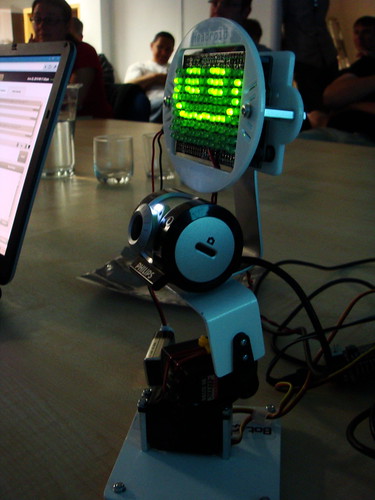As a research project months back Balthazar and I tested 3 modern face detection libraries (definitely see Balthazar’s write-up). Face.com had just been acquired by facebook, they had a great and free service which annotated not just face locations but also sex, age and emotion. We also tested OpenCV (popular and free) and the lesser known libccv.
Previously I’d used openCV to build a face tracking robot head in Python and we figured a review of what’s easily available might be fun:
Balthazar ran the face detection process with face.com and OpenCV, I added libccv. We used 200 images kindly provided by Rosario Rascuna (@_sarhus), collected from Instagram and annotated by us. We listed 150 images with faces and 50 without to test how often faces are correctly detected and whether faces are seen where they shouldn’t be.
We did not test the locations of the face, just the absolute count per image. This means that a face could be incorrectly spotted in an image whilst the true face was missed – our scoring system would still say ‘1 was expected and 1 was found so that is correct’. Manual inspection suggested that this is a minor problem (though if I ran the experiment again I’d take the time to hand-annotate every face’s location and check that faces were detected in the right place).
OpenCV provides a set of pre-trained data files (as xml with names like alt_tree_cascade), we tested them individually and then combined all their detections into an uber-detector. The goal for OpenCV was just to see how well it might do without fine tuning.
For OpenCV we used v2.3, for libccv we used v0.1.
I’ll be posting some of the code that we used along with the dataset, I’ll update a link here when I’ve done that.
Results:
- face.com found 144 of the 150 images with faces with 0 false positives (i.e. it didn’t say once that an image without a face had a face)
- OpenCV found 93 images with faces of the 150 images and an additional 4 that were false positives
- libccv found 99 images with faces of the 150 images and an additional 6 that were false positives
The short story is that the open source tools are ‘pretty good’ but face.com was better (and is now unavailable). Since this piece of work Stephen’s LambdaLabs offers a RESTful face detection (and recognition) API, I’ve not evaluated it.
There’s clearly room for a web based service in this area, training it with feedback would be a nice feature. Adding face recognition (as LambdaLabs has, but OpenCV/libccv doesn’t) is an obvious bonus. I’ve seen face detection used for:
- cropping uploaded faces in web profile pictures
- filtering non-face photos from photo albums
- filtering face photos from restaurant review sites
I suspect we’ll see more computer vision APIs that make it easier to annotate images (much the reason why I’ve registered this skeleton site for annotate.io), given the rise in photos on sites like Instagram (and flickr before).
Ian is a Chief Interim Data Scientist via his Mor Consulting. Sign-up for Data Science tutorials in London and to hear about his data science thoughts and jobs. He lives in London, is walked by his high energy Springer Spaniel and is a consumer of fine coffees.
